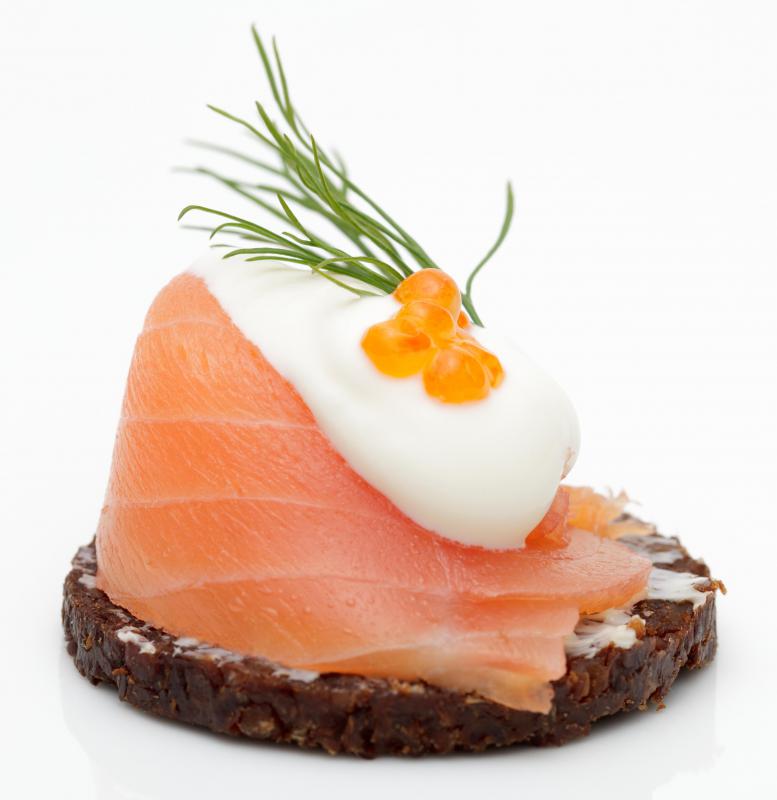At AllThingsNature, we're committed to delivering accurate, trustworthy information. Our expert-authored content is rigorously fact-checked and sourced from credible authorities. Discover how we uphold the highest standards in providing you with reliable knowledge.
What is Alaskan Salmon?
Alaskan salmon is Pacific salmon which has been harvested in the state of Alaska. Since it is often wild-caught, rather than farmed, many people who are concerned about sustainable fishing practices seek out Alaskan salmon specifically in the stores. The state has recognized the market for the valuable commercial product, and has launched advertising campaigns to promote Alaskan salmon and to educate consumers about the fish.
Pacific salmon is an umbrella term for fish in the genus Oncorhynchus. All Pacific salmon are anadramous, which means that they spawn in fresh water, but live in the ocean for most of their lives. The flesh of Pacific salmon is highly prized because of its unusual pink flavor, flavor, and nutritional value. Salmon is very high in omega 3 fatty acids, which are highly beneficial to humans. Alaska is an excellent source for salmon, since the fish are plentiful in Alaskan waters.

Five commercially valuable species are sold as Alaskan salmon. The largest is O. tschawytscha, known informally as Chinook or King salmon. This species of Alaskan salmon is high in oil, with a blue to green back dappled with small spots. The smallest species of Alaskan salmon is O. gorbusha, pink salmon or humpy. These fish are silver, with heavily spotted bodies.

Another commonly harvested fish is O. keta, known as silverbrite or keta salmon. Fishermen also seek out Coho salmon, O. kisutch, the most commercially prized species, also known as silver salmon. Finally, O. nerka, or sockeye salmon, is also fished in Alaskan waters. These salmon from Alaska can be found smoked, frozen, and fresh in many locations, and some consumers believe that they also have a superior flavor when compared to other salmon.

When selecting Alaskan salmon, people should try to seek out wild-caught salmon, if possible. Fish farming is sometimes accompanied with questionable environmental practices, especially in the case of salmon, since the delicate fish require a great deal of care, including large amounts of antibiotics. Most fish counters have labels indicating whether fish is wild caught or farmed, and these labels are actually required in some parts of the United States. People should also look for salmon with evenly colored, moist flesh that does not look soggy or too dry. Discolorations and slimy spots are indicators that the fish is of poor quality, or that is was handled badly.
There are many culinary uses for Alaskan salmon. It can be baked, grilled, roasted, steamed, sauteed, or fried. Many people enjoy broiled salmon as well, often with a simple and mild sauce which allows the flavor of the salmon to come out. For a very simple broiled salmon recipe, try preheating your broiler while you prepare a sauce with lemon, olive oil, fresh dill, salt, and pepper. Dredge the fish in the sauce before placing it in an ovenproof pan and broiling it for five to seven minutes, or until done, and serve it with lemon slices.
Frequently Asked Questions
What species of salmon are found in Alaska?
Alaska is home to five species of Pacific salmon: Chinook (King), Sockeye (Red), Coho (Silver), Pink (Humpy), and Chum (Dog). Each species has unique characteristics and migratory patterns. For instance, the Chinook salmon is the largest and can weigh over 30 pounds, while the Pink salmon is the smallest, averaging around 3.5 pounds.
Why is Alaskan salmon considered to be of high quality?
Alaskan salmon is renowned for its high quality due to the pristine, cold waters of the North Pacific where it thrives. These conditions lead to a natural diet rich in marine nutrients, contributing to the salmon's robust flavor and high content of omega-3 fatty acids. Sustainable fishing practices in Alaska also ensure the salmon's purity and health benefits.
How does the Alaskan salmon industry impact the environment?
The Alaskan salmon industry is a global leader in sustainable fishing practices. According to the Alaska Department of Fish and Game, the state's constitution mandates that fish, including salmon, be utilized, developed, and maintained on the sustained yield principle. This ensures minimal impact on ecosystems and maintains healthy fish populations for future generations.
What is the nutritional value of Alaskan salmon?
Alaskan salmon is highly nutritious, offering a rich source of protein, essential vitamins like B12 and D, and minerals such as selenium. It's particularly valued for its omega-3 fatty acid content, which supports cardiovascular health, cognitive function, and joint health. A 3-ounce serving of wild-caught salmon can provide up to 1,500 milligrams of omega-3s.
How is Alaskan salmon harvested?
Alaskan salmon is harvested using methods like purse seining, gillnetting, and trolling, which are regulated to ensure sustainability. The state employs strict seasonal and area-specific fishing quotas to prevent overfishing. Additionally, hatchery programs support wild stocks by releasing juvenile salmon into the wild, thus bolstering natural populations.
Can you explain the salmon run and its significance in Alaska?
The salmon run is an annual event where salmon return from the ocean to their natal freshwater streams to spawn. This migration is crucial for the species' lifecycle and has significant ecological and cultural importance in Alaska. It supports local wildlife, such as bears and eagles, and is integral to the subsistence lifestyle of many indigenous communities.
AS FEATURED ON:
AS FEATURED ON:













Discussion Comments
Alaskan salmon is only wild caught. Probably one of the best fish to eat, healthy and great source of omega 3.
Post your comments